Today sales of laptops based on the new energy-efficient Intel Core Ultra 200V (Lunar Lake) processors began. Most reviewers (and there are not many of them yet) have gotten their hands on the Asus Zenbook S14 OLED laptop based on Core Ultra 7 258V. In this material, we have collected the most interesting data from reviews of this laptop from the Tom’s Hardware and PCWorld portals.
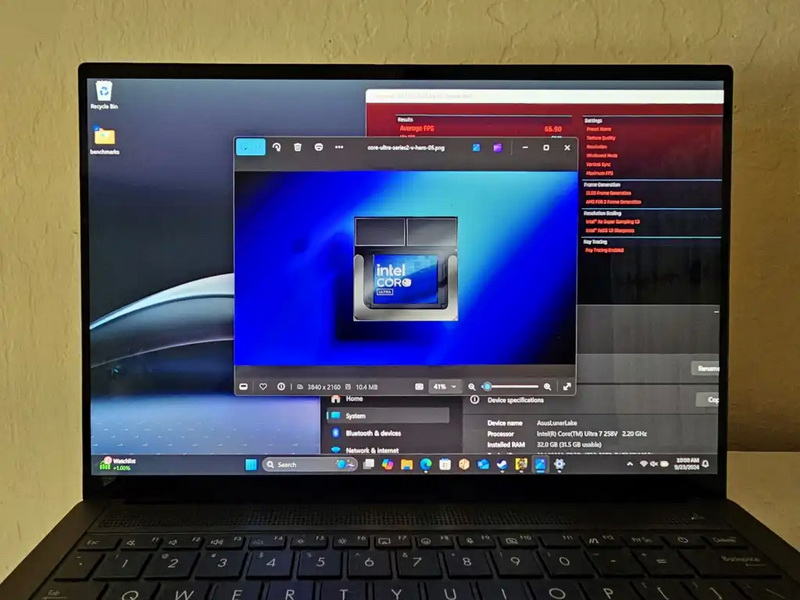
Image source: Mark Hachman/IDG
The Asus Zenbook S14 OLED uses an eight-core Core Ultra 7 258V processor, which has four high-performance Lion Cove P-cores with a frequency range from 2.2 to 4.8 GHz and four energy-efficient Skymont E-cores operating at frequencies from 2.2 to 4.8 GHz. 3.7 GHz. Lunar Lake chips do not support Hyper-Threading technology, so they only work with eight computing threads. Also included in the Core Ultra 7 258V is an AI accelerator (NPU) with a performance of 47 TOPS (trillion operations per second) and new integrated Arc 140V graphics. Another important feature of Lunar Lake processors is the built-in LPDDR5X-8355 RAM, of which the Core Ultra 7 258V has 32 GB. In other words, it will not be possible to increase the amount of available RAM in laptops based on Core Ultra 200V.
The new Asus Zenbook S14 OLED is equipped with a 14-inch screen with a resolution of 2880 × 1800 pixels and a refresh rate of 120 Hz. The laptop received a 1 TB SSD with PCIe 4.0, and also offers an Intel BE201 adapter with Wi-Fi 7 and Bluetooth 5.4. In offline mode, the device runs on a 73 Wh battery.

For comparison with the Asus Zenbook S14 OLED, PCWorld portal selected the following laptops:
- Asus Zenbook S16 based on a 12-core and 24-thread Ryzen AI 9 HX 370 with integrated Radeon 890M graphics and a 50 TOPS NPU, equipped with a screen with a resolution of 2880 × 1800 pixels;
- Microsoft Surface Laptop based on a 12-core Snapdragon X Elite (X1E-80-100) with a frequency of up to 4.0 GHz, a 45 TOPS NPU and integrated Qualcomm Adreno X1 graphics, as well as a screen with a resolution of 2304 × 1536 pixels;
- MSI Prestige 16 AI EVO is based on a 16-core and 22-thread Intel Core 7 Ultra 155H with a frequency of up to 4.8 GHz, integrated Arc graphics of the previous generation, equipped with a screen with a resolution of 2560 × 1600 pixels.
Tom’s Hardware, in turn, in addition to solutions based on AMD Ryzen and Snapdragon X Elite, also added for comparison a 15-inch MacBook Air based on the eight-core Apple M3 processor.
It should be added that the PCWorld portal conducted its tests of the Asus Zenbook S14 OLED in two power consumption modes. In the first case, all Intel and AMD based laptops used the Windows “Balanced” power plan. And for the laptop running Snapdragon X Elite, the lowest settings were used. The Asus Zenbook S14 OLED was also tested with the “Maximum Power Consumption” power plan. On the test charts it is marked with the prefix “MAX”. The Tom’s Hardware portal does not specify at what power consumption settings the tests were conducted.
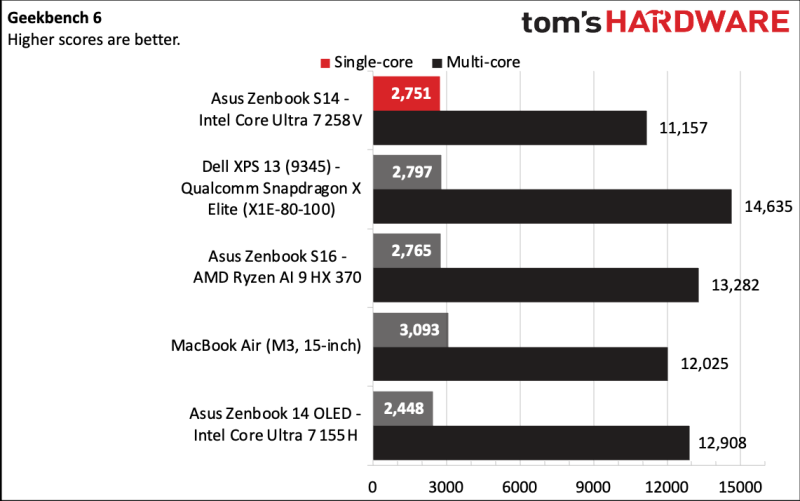
According to Tom’s Hardware, the single-threaded Core Ultra 7 258V in the Asus Zenbook S14 OLED was almost on par with its competitors. In the single-core Geekbench 6 test, the new product from Asus scored 2751 points. In the multi-core test, the result was 11,157 points. In terms of single-core performance, the new Intel chip was close to the performance of the Dell XPS 13 and Asus Zenbook S16 laptops based on Snapdragon X Elite and Ryzen AI, respectively. However, the Core Ultra 7 258V was slightly behind the Apple M3 processor (3093 points). Multi-threaded performance in this benchmark was lower than that of competitors. The second from last was the Apple M3. This is understandable, since other chips have more processing cores.
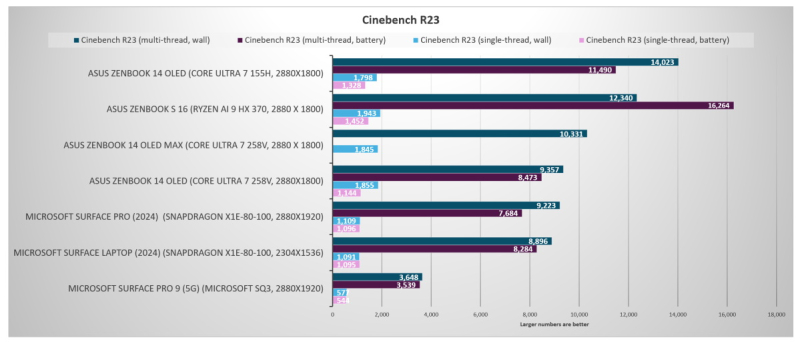
In the data transfer test, the new Zenbook based on the Core Ultra 7 258V copied 25 GB files at a speed of 1007.29 MB/s. The result was better than the Zenbook S16 (908.45 MB/s), but the Snapdragon-based XPS, MacBook Air and last year’s Zenbook S14 OLED were more effective in this task. Their results were 1342.05 MB/s and 1167.29 MB/s.
The Core Ultra 7 258V performed poorly in the Handbrake test for transcoding video from 4K to 1080p. According to Tom’s Hardware, the chip completed the task in 8 minutes and 28 seconds, which is worse than the results of other laptops presented in the comparison. The same Qualcomm Snapdragon X Elite as part of the Dell XPS 13 (9345) coped with the same task in 4:47 (the fastest result). PCWorld also compared the performance of laptops in Handbrake 1.8 when transcoding video, but with a different file, which took the Core Ultra 7 258V an hour to process, almost twice as long as the Ryzen AI 9 HX 370. The situation was slightly improved by choosing the “Maximum Performance” power plan. in Windows, which allowed the Core Ultra 7 258V to outperform the Snapdragon X Elite in this task.
The PCWorld portal compared the performance of the integrated graphics of the Core Ultra 7 258V with competing solutions. For this purpose, the 3DMark test was used, as well as the games Shadow of the Tomb Raider and Cyberpunk 2077.
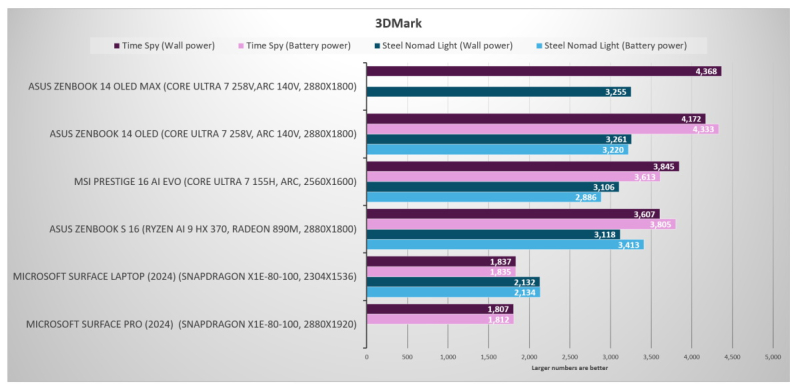
With the recommended power management settings, the Arc 140V graphics in the Core Ultra 7 258V turned out to be more productive than the competitors’ graphics. The switch to the Maximum Performance power plan widened this gap.
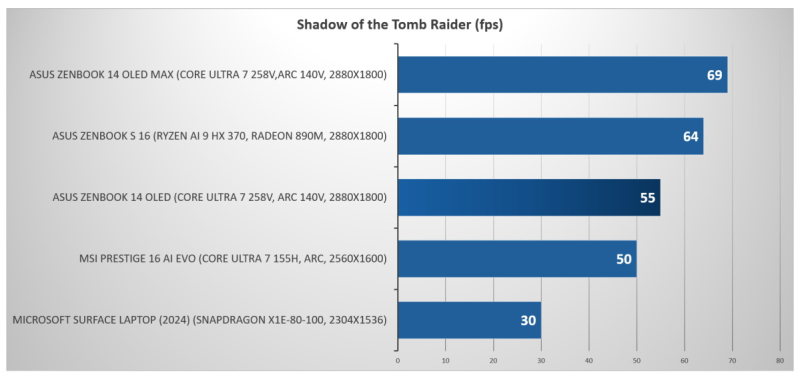
In Shadow of the Tomb Raider, the Arc 140V graphics were faster (55 frames per second) compared to the Snapdragon X Elite processor, which averaged only 30 frames per second. Switching to the Maximum Performance power plan in Windows allowed the Arc 140V to outperform the Radeon 890M graphics of the Ryzen AI 9 HX 370 processor and the Arc graphics of the predecessor Intel Core 7 Ultra 155H.
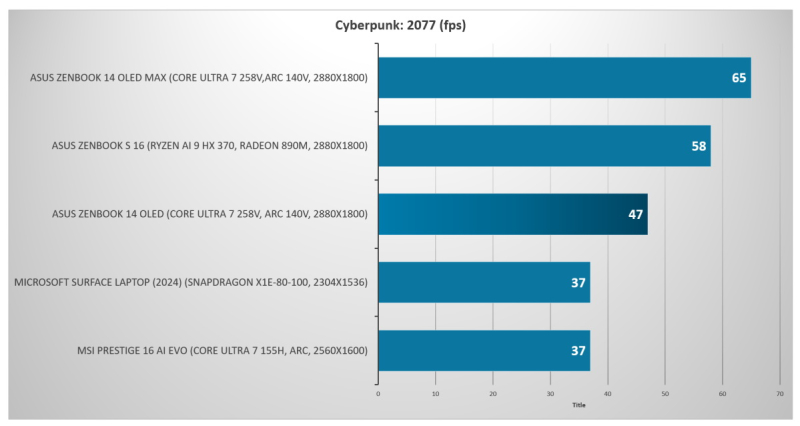
The picture was preserved in Cyberpunk 2077. In balanced power consumption mode, the new Arc 140V graphics demonstrated 47 frames per second, outperforming the built-in Snapdragon X Elite and Core Ultra 7 155H chips. In maximum performance mode, it was the fastest, demonstrating 65 frames per second. The same Radeon 890M showed only 58 frames per second.
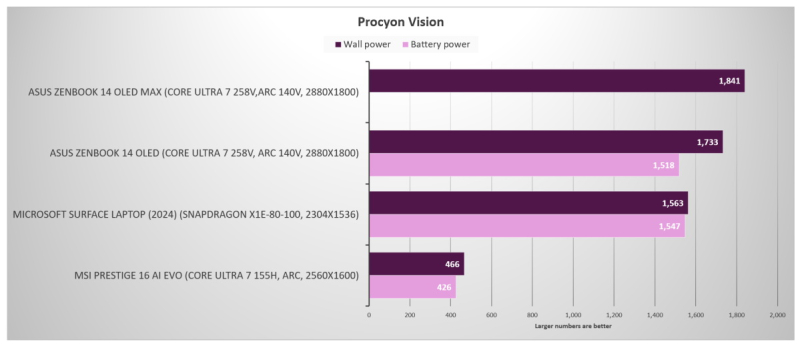
The AI performance of the Core Ultra 7 258V in the Procyon Vision test was slightly higher than that of the Snapdragon X Elite and significantly higher than that of the Core 7 Ultra 155H. In the Procyon image generation test, the newcomer also significantly outperformed its predecessor.
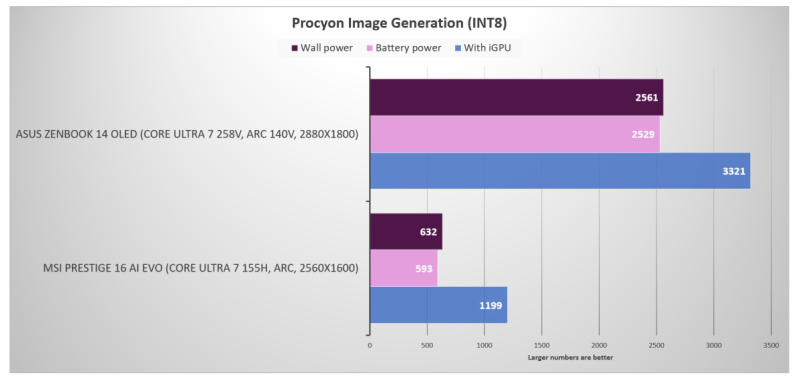
According to PCWorld, the Intel Lunar Lake-based laptop lasted an average of 17 hours and 7 minutes. The maximum operating time was 21 hours (conditions not specified). The time for the Qualcomm Snapdragon X Elite-based laptop was 16 hours and 20 minutes, the Ryzen AI 9 HX 370-based system was 10 hours and 42 minutes, and the Intel Meteor Lake-based laptop was 10 hours and 35 minutes. Tom’s Hardware reports that its new Zenbook S14 OLED lasted an average of 14 hours and 7 minutes. Dell XPS 13 (9345) based on Qualcomm Snapdragon X Elite (X1E-80-100) lasted 19 hours and 31 minutes. At the same time, the laptop is equipped with a less capacious 55 Wh battery. At the same time, the Dell XPS 13 received a display with support for Full HD resolution, which definitely also affected its battery life. According to Tom’s Hardware, the M3-based 15-inch MacBook Air lasted 15 hours and 3 minutes. It is not equipped with an OLED screen, but its display supports a higher resolution of 2880 × 1864 pixels.
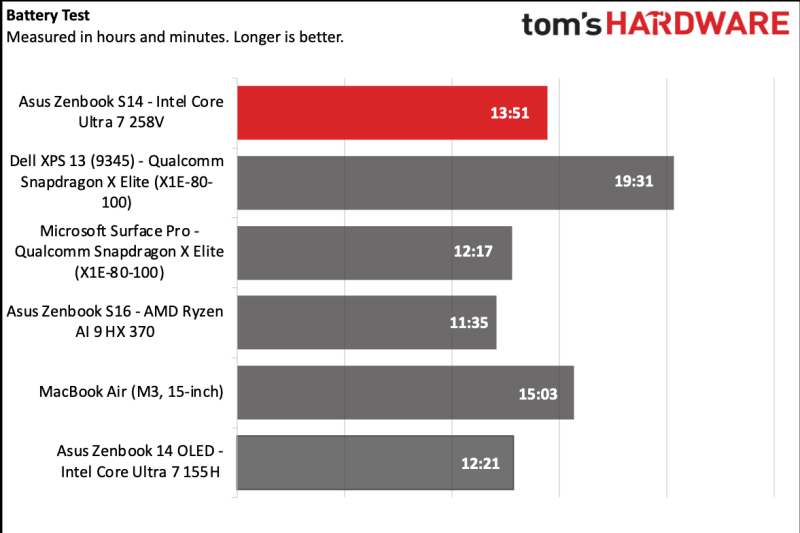
It would be wrong to draw conclusions about the entire Core Ultra 200V platform based on a review of a single laptop based on a single processor. Tom’s Hardware agrees. The portal notes the high single-core performance of the Core Ultra 7 258V, which should be enough for most everyday tasks, but at the same time, the multi-core performance of the new energy-efficient Intel processor may not be enough for resource-intensive tasks.
PCWorld, in turn, says that the energy efficiency of a laptop based on the specified Intel processor is quite competitive with systems based on Qualcomm Snapdragon X Elite. In many resource-intensive tasks, the AMD Ryzen processor copes better, but it provides lower autonomy. The portal adds that in tasks that require CPU performance, the Lunar Lake chip shows average results. At the same time, journalists were pleasantly surprised by the performance of the integrated graphics of the new processor and NPU.